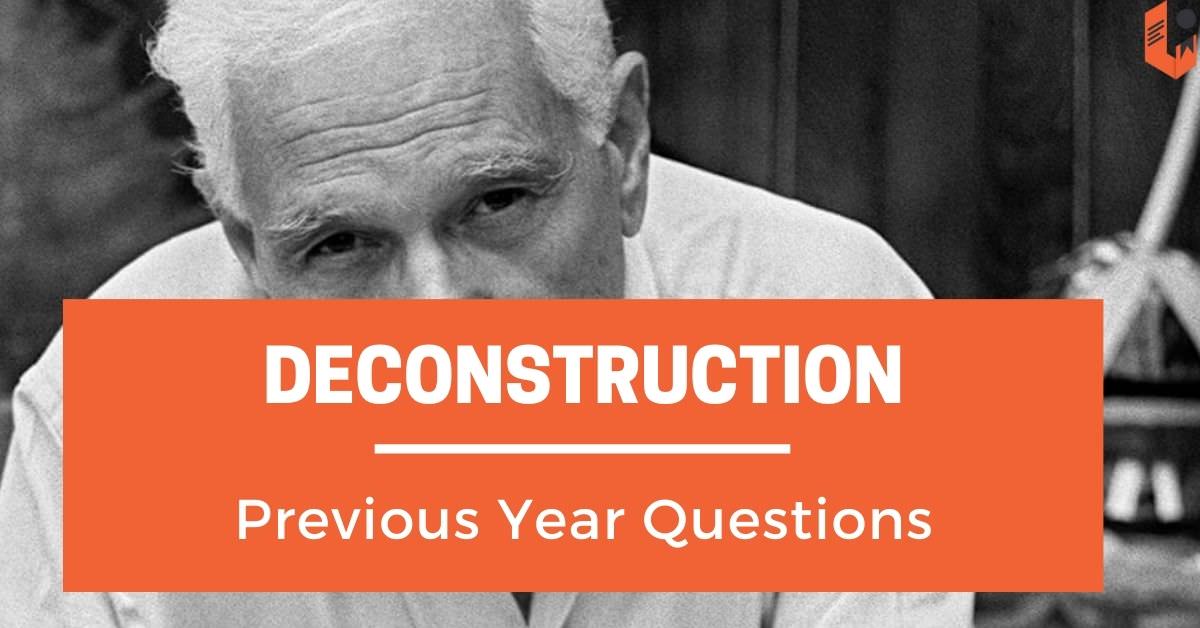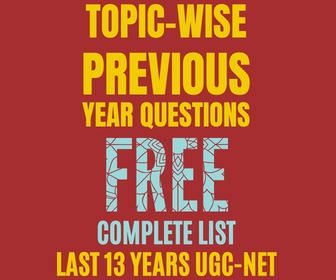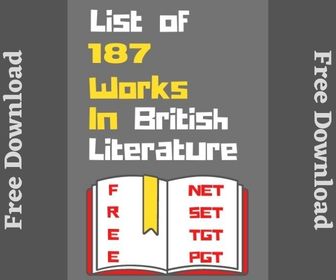UPDATE: Now, you can get these 3000+ questions in booklet/hardcopy format. Click here to know more.
In his “Structure, Sign, and Play in the Discourse of the Human Sciences,” Derrida is all praise for the bricoleur whom Levi-Strauss sees as a supreme methodologist, “someone who uses ‘the means at hand’.” Who does Levi-Strauss contrast bricoleur with in terms of method and approach?
(A) The Botanist
(B) The Anthropologist
(C) The Engineer
(D) The Semiotician
Ans: (C)
One of the key terms in Michel Foucault’s work is discourse. This is best described as
(A) the power of persuasion in all articulations.
(B) the selective language powerful people use.
(C) conceptual frameworks which enable some mode of thought and deny or severely constrain certain others.
(D) the ability to suggest transcendental levels of meaning in an utterance.
Ans: (C)
Which of the following statements is not applicable to Derrida’s rejection of the notion of the ‘Metaphysics of Presence’?
(A) The desire for immediate access to meaning privileges presence over absence.
(B) All presences are necessarily metaphysical and, therefore, are to be rejected.
(C) A fleeting meaning of the text is created through the play of ‘difference’ and ‘differance’.
(D) Metaphysics involves installing hierarchies and orders of subordination in the various dualisms that it encounters.
Ans: (B)
Michel Foucault’s earlier “archaeological” study is found in
(A) Power/Knowledge
(B) Social Theory and Transgression
(C) The Birth of the Clinic
(D) Beyond Structuralism and Hermeneutics
Ans: (C)
Which of the following in Jacques Derrida’s epigraph to his “Structure, Sign and Play in the Discourse of the Human Sciences” ?
(A) More body, hence more writing. ……. Helene Cixous.
(B) We need to interpret interpretations more than to interpret things. ……… Michel Eyquem de Montaigne.
(C) But unlike philosophical reflection, …. the reflections we are dealing with here concern rays whose only source is hypothetical … Claude Levi-Strauss
(D) If Cleopatra’s nose had been shorter the whole history of the world would have been different. ………Blaise Pascal.
Ans: (B)
Given below are two statements, one labelled as Assertion (A) and the other as Reason (R).
Assertion (A) : To give a text an author is to impose a limit on that text, to furnish it with a final signified, to close the writing.
Reason (R) : A text is made up of multiple meanings drawn from many sources, and this multiplicity is focused on the reader.
In the context of the two statements, which one of the following is correct :
(A) Both (A) and (R) are true and (R) is the correct explanation of (A).
(B) Both (A) and (R) are true and (R) is not the correct explanation of (A).
(C) (A) is true but (R) is false.
(D) (A) is false but (R) is true.
Ans: (B)
Match the following : Terms Description
(a) Ambiguity
(b) Aporia
(c) Intertextuality
(d) Heteroglossia
(i) A term coined by Julia Kristeva to refer to the fact that texts are constituted by a .tissue of citations..
(ii) A term used by Mikhail Bakhtin to describe the variety of languages and voices within a novel.
(iii) An irresolvable internal contradiction or logical disjunction in a text, usually associated with deconstructive thinking.
(iv) A term made famous by William Empson to indicate that a word, phrase, or text can be interpreted in more than one way.
(a) (b) (c) (d)
(A) (iv) (i) (ii) (iii)
(B) (ii) (iii) (iv) (i)
(C) (iv) (iii) (i) (ii)
(D) (iii) (iv) (i) (ii)
Ans: (C)
Assertion (A) : Arts will often work obliquely, by myth or symbol. They may make their best criticism of life simply by being; they may best state by not stating.
Reason (R) : It follows, if even only part of all this is true, that the arts do have an important social function. Arts can give greater depth to a society’s sense of itself. A country without great art might be a powerful collection of thriving earthworms hut would be a sorry society.
(A) Reason (R) is perfectly aligned with Assertion (A)
(B) Assertion (A) is unrelated to Reason (R)
(C) Assertion (A) hardly reflects Reason (R).s elaboration
(D) Reason (R), in fact, contradicts Assertion (A)
Ans: (A)
(a) Jean Baudrillard tells us the postmodern societies are marked by simulacra.
(b) By simulacra he means non-representations of reality.
(c) Simulacra artificially produce a mediated world masquerading as authenticity.
(d) It was not Jean Baudrillard but his interpreters who coined the term .simulacra.
Which of the above statements are true?
(A) (b), (c) and (d)
(B) (a) and (c)
(C) (c) and (d)
(D) (b) and (c)
Ans: (B)
In Jean Francois Lyotard’s works the term “language games”, sometimes also called “phrase regimens” denotes :
I. the multiplicity of communities of meaning.
II. the breakdown of communities of meaning.
III. the innumerable and incommensurable separate systems in which meanings are produced.
IV. the singular system in which meanings are dispersed and displaced.
The right combination according to the code is
(A) I and IV
(B) I and III
(C) II and IV
(D) II and III
Ans: (B)
A new historical reading, above everything else, is influenced by the philosophy of
(A) Jacques Derrida
(B) Jacques Lacan
(C) Michel Foucault
(D) Theodore Adorno
Ans: (C)
Jacques Derrida’s work received some criticism from analytical philosophers. Who below was a critic of Derrida?
(A) John Searle
(B) Jean-Francois Lyotard
(C) Emmanuel Levinas
(D) Paul de Man
Ans: (A)
According to Roland Barthes, the “writerly text” is
(A) a unique expression of the writer’s individual genius
(B) consumed by way of a seemingly unitary meaning
(C) linked to active participation of the reader in the establishment of the text’s meaning
(D) immediately accessible to the reader
Ans: (C)
Who was the original English translator for Of Grammatology?
(A) Samuel Weber
(B) G.C. Spivak
(C) Paul de Man
(D) Jean-luc Nancy
Ans: (B)
Which Flemish poet is Jacques Derrida related to?
(A) Anton Bergmann
(B) Karel L. Ledeganck
(C) Jan Frans Willems
(D) Jan Van Beers
Ans: (D)
‘Anti – foundationalism’ holds that :
(A) Every theory poses different questions and, therefore, what counts as ‘fact’ and ‘truth’ differs in every case.
(B) All truth claims can be judged true or false, usually against empirical facts.
(C) Causal statements about the relationship between dependent and independent variables can be made.
(D) Truth is the foundation of all representational experience.
Ans: (A)
“A text is not a line of words releasing a single ‘theological’ meaning (the ‘message’ of the Author-God) but a multi-dimensional space in which a variety of writings, none of them original, blend and clash. The text is a tissue of quotations drawn from the innumerable centres of culture.”
Which of the following best expresses the position stated above?
(A) A text is a tissue of lies that has no referential and cultural validity.
(B) A text is a communication from the Author-God with multiple meanings.
(C) A text is a force field of ambiguity where meanings collapse in the face of opposition.
(D) A text is a linguistic construct without any unity of meaning and is linked to multiple sources of language and culture.
Ans: (D)
In his essay “From Work to Text” Roland Barthes says the following about the text :
I. The text is singular.
II. The text can be held in the hand.
III. The text is held in language.
IV. The text is a methodological field.
The right combination according to the code is
(A) I and III
(B) II and IV
(C) III and IV
(D) III and II
Ans: (C)
Which of the following thinker concept pair is correctly matched?
(A) I.A. Richards – Archetypal Criticism
(B) Christopher Frye – Mysticism
(C) Jacques Derrida – Deconstruction
(D) Terry Eagleton – Psychological Criticism
Ans: (C)
“There is nothing outside the text” is a key statement emanating from
(A) Feminism
(B) New Historicism
(C) Deconstruction
(D) Structuralism
Ans: (C)
The structural analysis of signs was practised by
(A) Michel Foucault
(B) Jacques Lacan
(C) Julia Kristeva
(D) Roland Barthes
Ans: (D)
“Panopticism” is the title of achapter in a well-known book by
(A) Roman Jakobson
(B) Jacques Lacan
(C) Michel Foucault
(D) Jacques Derrida
Ans: (C)
To refer to the unresolvable difficulties a text may open up, Derrida makes use of the term:
(A) aporia
(B) difference
(C) erasure
(D) supplement
Ans: (A)
According to Barthes, a text which draws attention to its artifice, to the ways in which it is structured, is called
(A) Writerly text
(B) Aesthetic text
(C) Readerly text
(D) Formal text
Ans: (A)
Which of the following works cannot be categorised under postcolonial theory?
(A) Nation and Narration
(B) Orientalism
(C) Discipline and Punish
(D) White Mythologies
Ans: (C)
“Power circulates in all directions, to and from all social levels, at all times.” Who said this?
(A) Edward Said
(B) Michel Foucault
(C) Jacques Derrida
(D) Roland Barthes
Ans: (B)
The etymological meaning of the word “trope” is
(A) Gesture
(B) Turning
(C) Mirror
(D) Desire
Ans: (B)
Match the items in List – I with items in List – II according to the code given below :
List – I (Theorist)
i. Michel Foucault
ii. Judith Butler
iii. Alan Sinfield
iv. Eve Kosofsky Sedgwick
List – II (Book)
1. Gender Trouble
2. Epistemology of the Closet
3. History of Sexuality
4. Cultural Politics-Queer Reading
Which is the correct combination according to the code :
Codes :
i ii iii iv
(A) 3 1 2 4
(B) 3 1 4 2
(C) 4 2 1 3
(D) 4 3 1 2
Ans: (B)
Derrida’s American disciples were
(A) Geoffrey Hartman, Paul de Man, J. Hills Miller
(B) Gertrude Stein, Barbara Johnson, Michael Ryan
(C) Barbara Johnson, Michael Ryan, Mary Ellman
(D) Jean Baudrillard, Gilles Deleuze, Felix Guattari
Ans: (A)
According to Foucault sexuality points to discourses about all the following EXCEPT
(A) Medicine
(B) Anthropology
(C) Psychology
(D) Criminology
Ans: (B)
Which country is Jacques Derrida born in?
(A) France
(B) South Africa
(C) Algeria
(D) Belgium
Ans: (C)
Which of the following is not Jacques Derrida’s work?
(A) Of Spirit : Heidegger and the Question
(B) The Transcendence of the Ego
(C) Of Grammatology
(D) The Work of Mourning
Ans: (B)
Which of the following statements does not describe Michel Foucault’s position?
(A) In Foucault’s work sexuality is literally written on the body.
(B) Power operates through discourse.
(C) There is connection between power and knowledge.
(D) Where there is power, it is possible to find resistance.
Ans: (A)
Foucault believes that the facts of history will protect us from
(A) repeating mistakes
(B) totalitarianism
(C) deconstructionism
(D) historicism
Ans: (D)
Identify the two important works of Paul de Man from the following list :
(a) Blindness and Insight
(b) Allegories of Reading
(c) Theoretical Essays
(d) Criticism and Ideology
The right combination according to the code is :
(A) (a) and (b)
(B) (a) and (c)
(C) (b) and (c)
(D) (b) and (d)
Ans: (A)
Who among the following proposed that the First Gulf War had never taken place, it was simply a hyperreal, media-generated spectacle?
(A) Richard Rorty
(B) Jean-Francois Lyotard
(C) Jean Baudrillard
(D) Umberto Eco
Ans: (C)
Deconstructionist critics argue that texts are never free from
(A) the equivocal and ironically unstable worldview of the author.
(B) the material conditions that determine the production and reception.
(C) the interpretations bestowed by the totalizing critic.
(D) distortions inherent in the rhetoricity of language.
Ans: (D)
“We know now that a text is not a line of words releasing a single “theological” meaning (the “message” of the Author-god) but a multidimensional space in which a variety of writings, none of them original, blend and clash . . . . literature . . . . by refusing to assign a “secret”, an ultimate meaning, to the text (and to the world as text) liberates what may be called an anti-theological activity , that is truly revolutionary since to refuse to fix meaning is, in the end to refuse god and his hypostases- reason, science, law.” The passage comes from which of the following essays?
(A) “tradition and individual talent” by T.S. eliot
(B) “discource in the novel “ by Mikhail bakhtin
(C) “what is an author?” by Michel Foucault
(D) “the death of the author” by roland barthes
Ans: (D)
By which two of the following processes, according to Michel Foucault, does power operate?
(a) By right rather than technique
(b) By normalization rather than law
(c) By control rather than punishment
(d) By repression rather than agreement
Choose the correct option :
(A) (a) and (c)
(B) (b) and (c)
(C) (b) and (d)
(D) (a) and (d)
Ans: (B)
Who among the following analysed the naturalizing of connotative meanings into myths?
(A) Michel Foucault
(B) Roman Ingarden
(C) J. Hillis Miller
(D) Ronald Barthes
Ans: (D)
Which of the following sociologists’ ideas on the practice of receiving and giving gifts are used by J. Hillis Miller to reinforce her arguments in the essay, Critic as Host
(A) Emile Durkheim
(B) Max Weber
(C) Marcel Mauss
(D) Daniel Bell
Ans: (C)
Match the critics and their works :
Critics Works
(a) Edward Said
(b) Terry Eagleton
(c) Francis Mulhern
(d) K. M. Newton
(i) The Illusion: of Postmodernism
(ii) Contemporary Marxist Criticism
(iii) Theory into Practice
(iv) Culture and Imperialism
Choose the correct option from those given below :
(A) (a-iv); (b-i); (c-ii); (d-iii)
(B) (a-iv); (b-i); (c-iii); (d-ii)
(C) (a-ii); (b-i); (c-iv); (d-iii)
(D) (a-i); (b-ii); (c-iii); (d-iv)
Ans: (A)
Who among the following explored the shifting and contested power-relations, knowledge and the human body?
(A) Louis Althusser
(B) Clifford Geertz
(C) Jacques Lacan
(D) Michel Foucault
Ans: (D)
Given below are two statements—one is labelled as Assertion (A) and the other is labelled as Reason (R) :
Assertion (A) : Language constructs meaning.
Reason (R) : Language structures meanings depending on the speaking subjects’ perception, context and auditor(s).
In the light of the above two statements choose the correct option:
a) Both (A) and (R) are true and (R) is the correct explanation of (A)
b) Both (A) and (R) are true but (R) is not the correct explanation of (A)
c) (A) is true, but (R) is false
d) (A) is false, but (R) is true
Ans: (a)
Which of the following describes Foucault’s views on knowledge?
(A) Knowledge is not metaphysical or transcendental
(B) Knowledge is not a matter of perspective.
(C) Knowledge is not pure or neutral but is always from a point of view
(D) Knowledge is unconstrained by regimes of power
Ans: (C)
Which of the following stylistic features characterize spoken discourse?
- Greater use of explicit connectives
- Greater dependence on verbal connectives
- Greater syntactic embedding
- Greater use of fillers and repitions
Choose the correct option:
(A) (a) and (b)
(B) (b) and (c)
(C) (c) and (d)
(D) (b) and (d)
Ans: (D)
Which two of the following are associated with Deconstruction?
- Jacques Derrida
- Raymond Williams
- Paul De Man
- Jonathan Dolli more
Choose the correct option:
(a) and (b)
(a) and (c)
(a) and (d)
(b) and (d)
Ans: (a) and (c)
Match the theorist with the text:
a) John Fiske
b) Michel de Certeau
c) Pierre Bourdieu
d) Jean Francois Lyotard
i. Distinction
ii. The Postmodern Condition
iii. Reading the Popular
iv. The Practice of Everyday Life
Choose the correct option:
(a)-(iii), (b)-(iv), (c)-(i), (d)-(ii)
(a)-(iv), (b)-(iii), (c)-(ii), (d)-(i)
(a)-(ii), (b)-(i), (c)-(iv), (d)-(iii)
(a)-(ii), (b)-(iv), (c)-(iii), (d)-(i)
Ans: (a)-(iii), (b)-(iv), (c)-(i), (d)-(ii)
Given below are two statements: one is labelled as Assertion A and the other is labelled as Reason R
Assertion A: Signs are never neutral or innocent.
Reason R: In all cases signs are organized into systems that convey some meaning.
In light of the above statements, choose the correct answer from the options given below
a) Both A and R are true and R is the correct explanation of A
b) Both A and R are true but R is NOT the correct explanation of A
c) A is true but R is false
d) A is false but R is true
Ans: a)
Who among the following presented the concept of ‘multi-accentuality of the sign, saying that signs possess an Inner dialectical quality and ‘evaluative accent’?
(A) Roland Barthes
(B) Stuart Hall
(C) Jacques Derrida
(D) Valentin Voloshinov
Answer: (D)
Which one of the following assumptions best expresses the position of Post-Structuralist criticism?
(A) Definite structures underlie empirical events.
(B) Language is representational.
(C) Apprehension of reality is a construct.
(D) Knowledge operates according to procedures that are axiomatic.
Ans: (C)
Match List I and List II
List I
Terms
A. Superreader
B. Biopower
C. Bricolage
D. Chronotope
List II
Theorists
I. Michel Foucault
II. Mikhail Bakhtin
III. Michael Riffaterre
IV. Claude Levi-Strauss
Choose the correct answer from the options given below:
A – III, B – II, C – IV, D – I
A – III, B – I, C – IV, D – II
A – IV, B – I, C -III, D – II
A – II, B – I, C – IV, D – III
Ans: A – III, B – I, C – IV, D – II
Match List I and List II
List I
Terms
A. arche-ecriture
B. cyborg
C. genotext
D. hermeneutic circle
List II
Theorists
I. Julia Kristeva
II. Donna Haraway
III. Friedrich Schleiermacher
IV. Jacques Derrida
Choose the correct answer from the options given below:
a) A – IV, B – II, C – I, D – III
b) A – III, B – I, C – II, D – IV
c) A – III, B – II, C – IV, 0 – I
d) A – IV, B – I, C – II, D – Ill
Answer: (a)





Thank you sir
You’re weclome, Aishwarya.
Very informative..thanks
Ab NET pass krne se koi nahi rok paega🤘😅yyaass!!!!